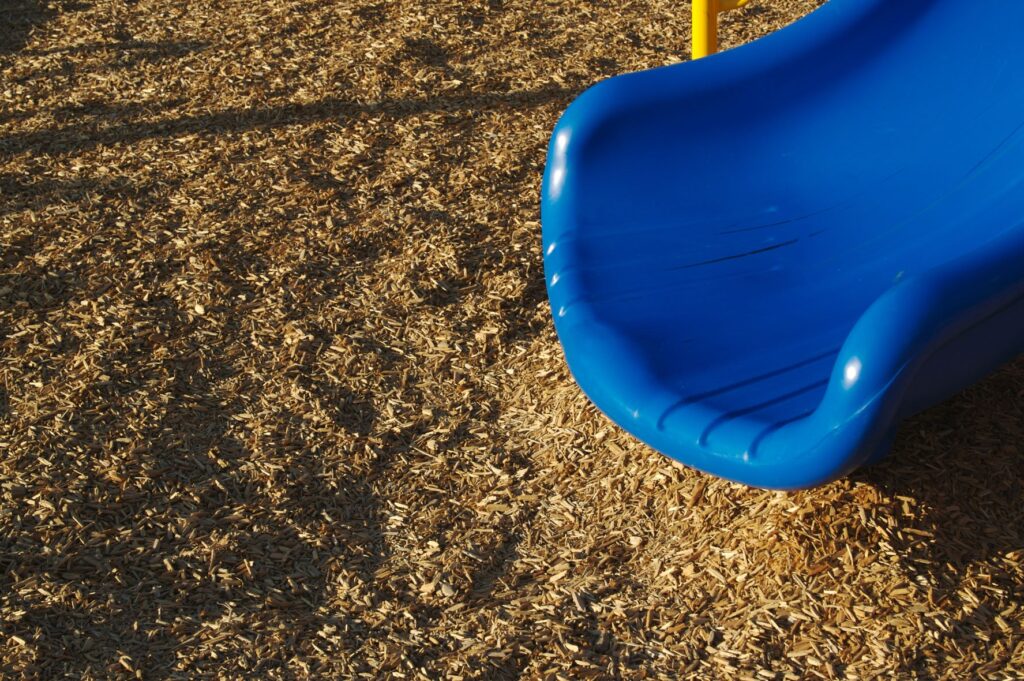Play is an essential part of childhood development as children learn through play. Public playgrounds provide an environment for children to develop physical, behavioral, and cognitive skills. Though an essential aspect of childhood development, public play areas can also provide an opportunity for serious injuries and fatalities. In 2020, 120,829 children sustained serious injuries on public playgrounds that required treatment in an emergency room (NEISS, 2020). Of those injured children, approximately 5.6% died as a result of their playground injuries (NEISS, 2020).
Death and debilitating injuries of children on public playground equipment can occur from entanglement, falls, head and neck entrapment, and impact. Entanglement occurs when the child’s clothes, or something around the child’s neck such as drawstrings, necklaces, etc., becomes caught or entwined on a component of the playground equipment. When entangled, children can sustain serious bodily injury and strangle to death. For the most part, playground owners cannot control what children are wearing while using a public playground. Therefore, the playground equipment must be designed in such a way as to limit protrusions that can catch something around a child’s neck. Generally, this can be accomplished by limiting any projections, sharp points, and partially bound openings on play equipment. For example, a protrusion located at the top of a slide could catch the necklace of a child going down. As the child slides down, she could become caught and strangle to death. Lacking coordination, upper body strength, and cognitive abilities, especially when frightened, children are less likely to be able to maneuver their bodies into a position to prevent injury and strangulation when entangled.
The second most common source of death and debilitating injuries of children on public playgrounds are falls onto hard underlying surfaces. The fall height of play equipment is the vertical distance between the highest accessible designated play surface of the equipment and the protective surfacing below. The designated play surface depends on the type of play equipment in question. For example, the fall height of upper body equipment, like the monkey bar, is the maximum height of the structure to the protective surfacing, while the fall height from an elevated platform is the height of the platform itself (i.e., where children walk) and the protective surface. Here, using the appropriate surfacing material underneath and around all areas of a public playground is essential to decreasing the possibility of serious injuries and death. All play surfacing material should conform to industry standards (See ASTM F2223 and ASTM F1292 for more information). Each type of playground surfacing material is rated with a “critical height.” Here the critical height of the protective surfacing material must equal or exceed the fall height of the play equipment it is located under. For example, if the monkey bars have a fall height of 7 feet, wood chips with a depth of 9 inches would be an appropriate choice of surfacing material due to its rated critical height of 10 feet. Here, if a child falls from the monkey bars onto the wood chip surface, they are less likely to sustain life threatening head injuries.

As children exit the slide, wood chips are scattered and displaced. Proper maintenance such as raking and replacing woodchips to ensure adequate and uniform depth across the play area is essential in maintaining the surface’s critical fall height.
The third most common source of playground serious injury and deaths are head and neck entrapments in play equipment openings. Entrapments are any condition which prevents withdrawal of a body or body part that has entered an opening. The ASTM F1487-21 states that “Public playground equipment shall be designed and constructed or assembled so that any accessible opening shall meet the following performance requirements to reduce the risk of accidental head or neck entrapment by either a head-first or feet-first entry into the opening.” Generally, openings that are between 3.5 inches and 9 inches and have a depth of greater that 4 inches are at risk of being an entrapment hazard (See ASTM F1487 for more information). Entrapments can occur in fully bound openings and/or partially bound openings. Entrapment hazards located further from the ground are more hazardous due to the increase in the likelihood of a child being strangled. Younger children, especially if scared or panicked, may not have the required intellectual ability or motor skills to reverse the process that caused their heads to become trapped.
The fourth most common type of serious playground injuries and deaths is impact by loose or moving equipment. This occurs when the moving parts of play equipment strike a child or the child on a moving part of play equipment strikes a stationary object. For example, the ASTM F1487 suggests that swings are positioned at least 72 inches away from any other stationary play structure to decrease the probability of a child impacting that adjacent structure while swinging. Improper playground site planning, broken, or improperly installed play equipment can cause impact injuries. For example, a swing set was installed 72 inches from a fast-growing tree. Though compliant during the installation, the tree quickly grew closer to the swing set. Eventually a child hit the tree while swinging and was seriously injured. Thoughtful consideration to the site planning of the playground site could have prevented this from occurring.

“FIG. A1.35” from ASTM F1437-21: Standard Consumer Safety Performance Specification for Playground Equipment for Public Use. This figure illustrates the minimum distances to place swings in order to prevent a swinging child from hitting another adjacent structure or another playing child.
Poor maintenance, inappropriate design, installation errors, site planning issues and improper use/lack of supervision can lead to entanglement, falls, head and neck entrapment, and impact injuries. Play equipment must be inspected and maintained to meet minimum safety standards and identify new hazards resulting from wear, vandalism, breakage, storm damage, litter, etc. Once identified, hazards can be repaired, barricaded, or removed to ensure children’s safety. Inappropriate design of playground equipment also contributes to injuries and death. Playground owners cannot control what children do or wear, so it is important to thoughtfully consider the design of the public playground equipment and site in accordance with all foreseeable uses. Playground equipment must be thoughtfully designed to eliminate hazards such as entanglement, entrapment, falls, and impacts. Here, playground areas must be properly installed, and their location thoughtfully planned to limit potential hazards and keep children safe. In addition, site planning issues such as flooding, landscaping, or close roadway hazards can introduce unforeseen hazards into the playground environment. These causal factors are largely preventable with proper maintenance, planning, and design of both equipment and the location.

Improperly maintained playground equipment can cause serious injuries and death. Equipment should be inspected and repaired/replaced as needed to prevent injuries.
Ellen Szubski, Ph.D., CXLT, CPSI, AHFP, is a human factors consultant at The Warren Group. She earned a Doctorate of Philosophy in Human Factors Psychology and a Master of Science in Applied Psychology from Clemson University. She did her dissertation on “The Influence of Pedestrian Biological Motion on Time-To-Collision Estimates at Night”. She is also a Certified XL Tribometrist, Certified Playground Safety Inspector and a Certified Associate Human Factors Professional (AHFP). Prior to entering the forensic field, Ellen planned and conducted experiments for a major bicycle manufacturer. She also conducted laser strike perception studies for the Department of Defense. Ellen applies her experience in Human Factors to the analysis of crash investigations and other personal injury matters. These matters often include collisions involving vulnerable road users and drivers, driver distraction, and slips, trips, and falls. She utilizes her knowledge of OSHA regulations, codes, and standards in her analysis of premises liability incidents and safety consulting. Ellen is a current member of the Human Factors and Ergonomics Society (HFES) and it’s Forensic Professional Technical Group.



